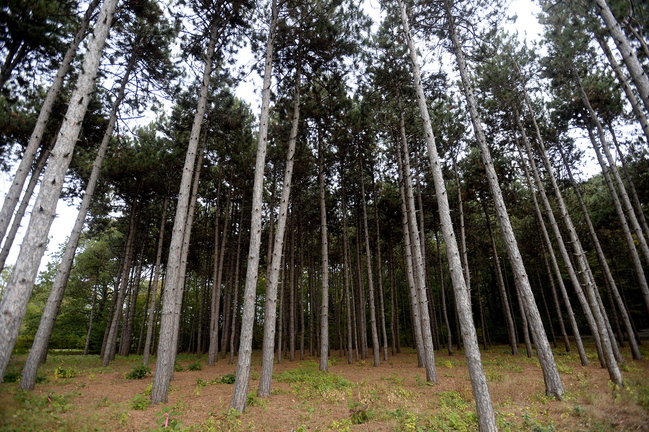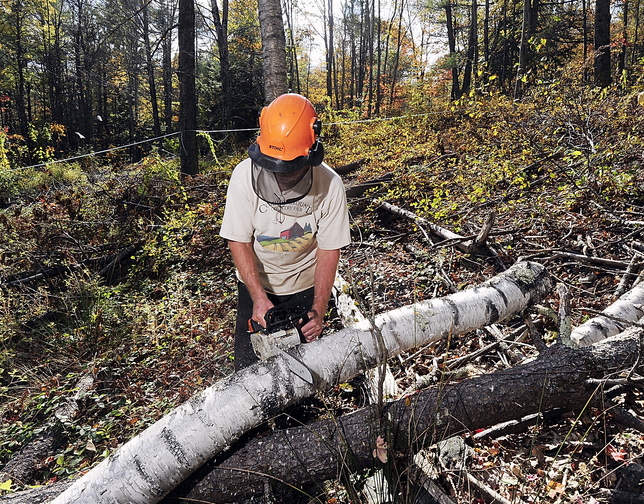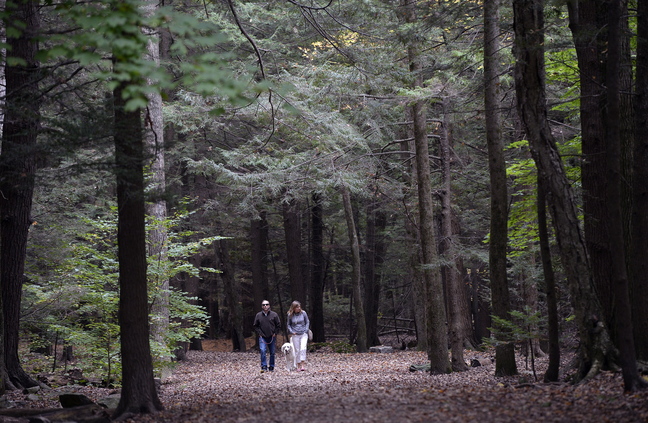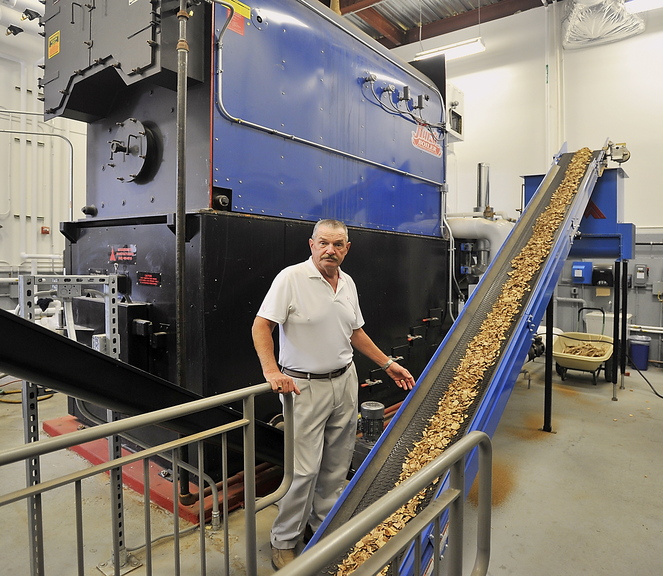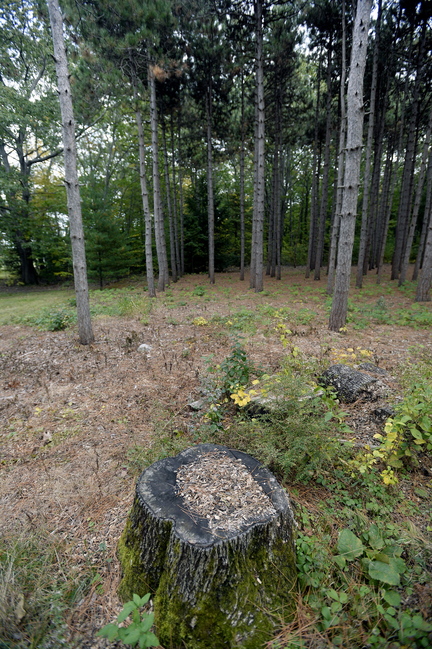In Bath, schoolchildren will tap trees in the community forest, learning a practical skill and producing a marketable item: Maine maple syrup.
In Machias, revenue from harvesting trees in the town forest is being funneled into the budget for schools.
In the Farm Cove Community Forest west of Grand Lake Stream, timber is being harvested twice a year and yielding hundreds of thousands of dollars to bolster land conservation and offer residents of Washington County jobs, firewood, and supplies for canoe building and crafts such as wreaths and baskets.
And in Falmouth, the high school is saving $100,000 a year by converting from oil to wood from Maine forests.
All of those activities, and savings, are part of the reinvigorated community forest, a newly recycled concept with a history in Maine going back at least 200 years.
Commonplace in Maine in the 1800s, the community forest is making a comeback because of its potential for profit and practical savings, spectacular aesthetics, hands-on education and a sense of history, many town officials say.
“This (community forest) is an old idea that had kind of fallen by the wayside,” said Jennifer Melville, Yarmouth-based vice president for grants and loans with the Open Space Institute in New York.
In the past 10 years, there has been a fundamental restructuring of the forest products industry, she said, and it has opened a niche for woodlands that are returned to local control and used by residents.
Communities in Maine have resurrected the notion in very real ways, redesigning their town woodlands into what Melville describes as “the resurgent community forest.”
With the help of conservation and land trust organizations dedicated to preservation of spaces that are still open, still relatively pristine and wild, tens of thousands of acres of forestland are being protected and harvested.
Melville said that, most recently, six towns – Jay, Denmark, Holden, Machias, Livermore and Canton – have committed land, time and energy to reviving the community forest model.
In Machias, for example, the community forest is right in town, within walking distance of the school and hospital, Melville said. Wood from the forest will be sold, and “some of the funding will go directly to the schools, and the forest and river will become part of the curriculum,” she said.
COMMUNITIES PROTECTIVE OF FORESTS
In the 1800s and 1900s, most Maine towns had their own forests, for logging, forestry, recreation and public access to remote lands.
But vast tracts of forestland, particularly in northern Maine, later became the property of paper and forestry companies.
Since the 1980s, hundreds of thousands of acres of forest have changed hands, from paper companies to investment owners, said Mark Berry, executive director of the Downeast Land Trust in Grand Lake Stream, which oversees the two largest community forest projects in Maine, totaling 55,000 acres in Washington and Hancock counties.
That massive transfer of ownership was accompanied by pressures from industrial management that led to ever-more-intensive harvesting, according to a 2007 study by the Community Forest Collaborative. It also evoked a visceral response from communities and “sparked an impressive series of conservation initiatives by state and national conservation organizations, land trusts and private agencies,” the study said.
Though much of the forest land remains in private ownership, with absentee property owners, including timber investors and national nonprofits, many communities have decided to take a more active role in guiding the future development of the land.
LOCAL STEWARDSHIP, LOCAL JOBS
Community forests combine values of conservation and forestry, said Berry, and they draw on a broad spectrum of support from the municipalities where they are located and surrounding communities.
“The biggest thing that makes … a community forest is that there is local leadership and stewardship,” Berry said.
Residents serve on the boards of directors and advisory committees, and they have a stake in the bounty the forests offer. As many as 100 timber jobs – about 30 direct and 70 indirect positions – are supported by the Downeast Land Trust’s Farm Cove Community Forest project, said Berry.
Trees are harvested in summer and winter at Farm Cove, and annually in parts of West Grand Lakes. Some 6,500 cords of wood are cut in Farm Cove during the summer and winter, said Berry.
The trust pays forestry companies – one from Washington County, another from Bangor – to harvest trees, said Berry. “And then we (the trust) get the proceeds from the sale of the wood.”
SAVINGS TO LOVE IN FALMOUTH
The renewed vitality of the community forest concept parallels a desire for local control and accountability in everything from politics to coastal planning, say representatives of land trusts, planning commissions and nature conservancies.
“It really is a grass-roots endeavor,” said Alan Hutchinson, executive director of the Forest Society of Maine in Bangor. “It’s (local residents) seeing that they can use the community forest to preserve the character, traditions and values of the town and guide development.”
Growing numbers of the nearly 170 municipalities in Maine that have town forests are taking a second look at the woods, which increasingly are being harvested for the economic value of the wood and for the health of the ecosystem, according to the Community Forest Collaborative study.
In woodlands, a portion of the trees have to be removed regularly to enhance the growing conditions, including available space, for those left standing. Maine municipalities are rediscovering how important that harvested wood can be, for town budgets, schools and low-income families – especially in financially stressed times.
Topper West, director of facilities, grounds and transportation for Falmouth schools, said heating with wood in the elementary, middle and high schools has saved hundreds of thousands of dollars over only a few years.
In the last three years, the town has converted from oil to wood biomass-boiler heat. At the high school alone, that has reduced costs from more than $150,000 a year for oil to less than $50,000 – give or take the ups and downs in pricing in both markets, he said.
It has enabled Falmouth to eliminate the use of oil, except as a backup source, for heating schools, West said.
“It’s one-third the cost of oil,” he said. “It’s so simple; it’s such a savings. How could anybody not love it?”
LARGEST MUNICIPAL FORESTS UPSTATE
Falmouth – along with Portland – has harvested wood from its own forests in the past and will again in the future, said Jan Santerre, Project Canopy coordinator with the Maine Forest Service.
Among its uses, besides heating, are recreation, education and tourism, which have prompted towns and cities to consider creative and inventive forest and wood-product programs close to home.
Some towns and regions have active forestry operations, selling wood and other forestry products for profit, Santerre said. Often, that money is funneled back into preserving woodlands and wild spaces. It has also been dedicated to the operations of the municipalities themselves, she said.
By far the largest community forests in the state cover more than 55,000 acres in two Downeast Land Trust projects in the rural regions of Hancock and Washington counties.
The Farm Cove Community Forest west of Grand Lake Stream has been preserved since 2008, with allowances for some harvesting, and an additional 22,000 acres of the West Grand Lake Community Forest is expected to be fully purchased for preservation by 2015, said Berry, with the Downeast Land Trust.
Local residents are allowed to harvest firewood – as in many community forests in the state. Canoe builders can take cedar and ash for their work, and craftsmen are permitted to take balsam fir boughs for wreaths and other projects, Berry said.
In the Downeast Land Trust, the two conservation areas represent diverse forests, primarily hemlock, as well as spruce, white pine, sugar maple, birch, beech and fir, Berry said.
They contain some of the most spectacular undeveloped lakes and other waterways, land, trees and wildlife in the region, he said. And each forest – commercially harvested for generations – maintains the tradition of active forestry.
One of the better known and larger community forests is Amherst Mountains Community Forest, nearly 5,000 acres surrounding six ponds in the town of Amherst, managed by the Maine Bureau of Parks and Lands. Under an agreement that established the community forest in 2011, harvesting of portions of the woodlands was allowed, with any proceeds shared between the state and the town.
The combination of alliances and advantages that such agreements make possible is compelling enough to have produced community forests in Maine that range from humble to huge.
Garfield Plantation, population 90, has 13,000 acres, and Winterville Plantation, with about 200 residents, has set aside almost as much, Santerre said. Augusta has 860 acres, Eagle Lake has 4,000, Mattawamkeag has 1,000, and Bethel has 175.
Lewiston has 600 acres, and Portland has about 500. “Both are managing those forestlands,” Santerre said. “Portland actively manages parcels as small as a couple of acres, mainly for safety and timber stand improvement.”
North Cairn can be contacted at 791-6325 or at:ncairn@pressherald.com
Send questions/comments to the editors.

